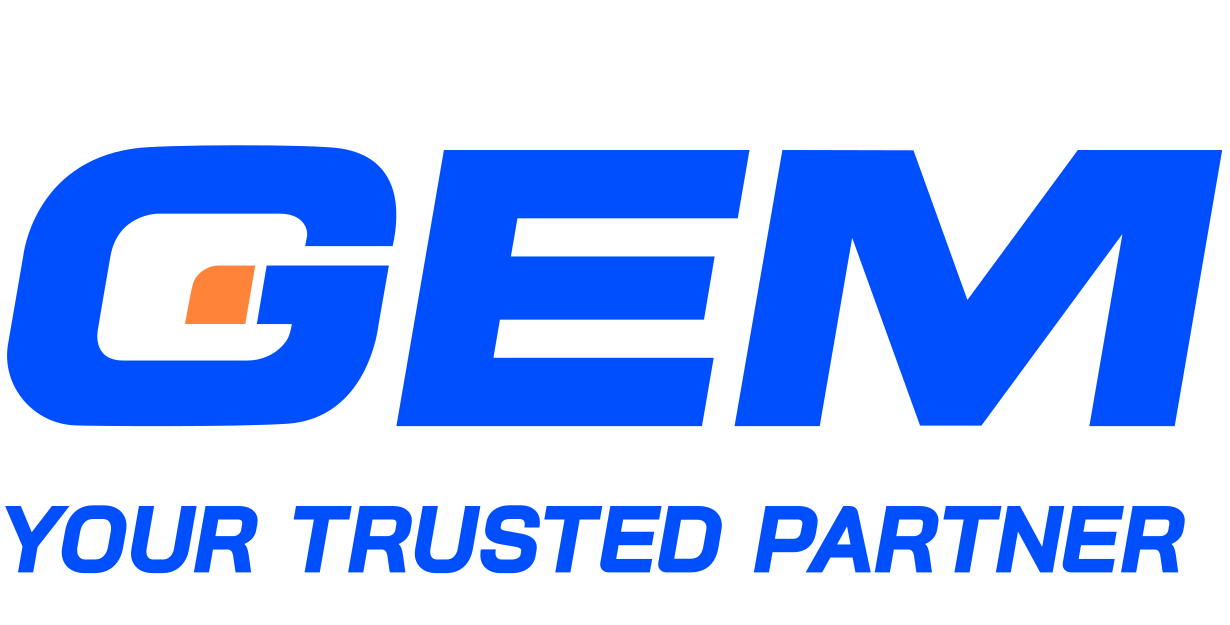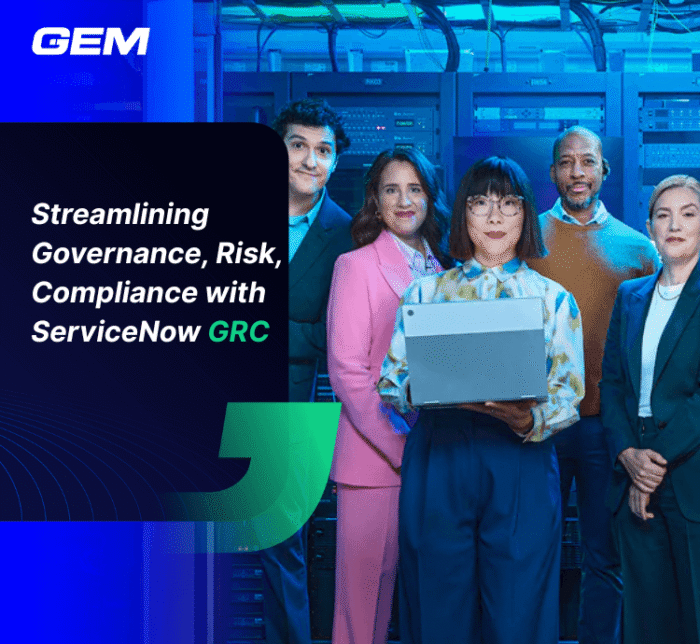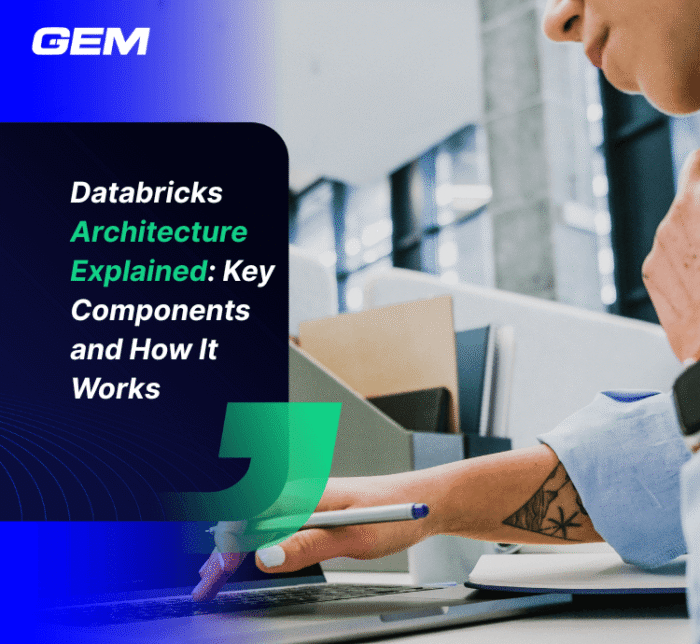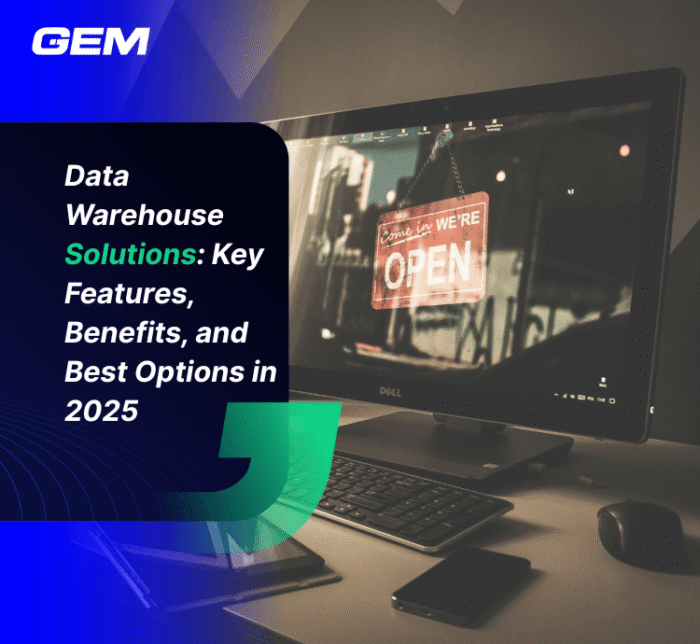Contents
- What is ServiceNow ITOM?
- Breaking Down the Core ServiceNow ITOM Modules
- What You Gain with ServiceNow ITOM: Functional and Strategic Value
- ITOM vs. ITSM: Where They Overlap – And Where They Don’t
- Stop trying to find the dots. Let us help you connect them!
- What’s the Real Cost? ServiceNow ITOM Pricing Packages
- ITOM Implementation Timelines and Complexity: What to Expect
- Measuring the ROI of ServiceNow ITOM
- Implementing ServiceNow ITOM with GEM Corporation
- Conclusion
ServiceNow ITOM is gaining traction among enterprises aiming to streamline operations, reduce incident noise, and automate infrastructure monitoring. Yet when it comes to pricing and implementation, most leaders face a lack of clarity around what the platform actually costs, how long it takes to deploy, and what kind of return to expect. With licensing models tied to infrastructure scale and multiple modules offered in tiers, the total investment can vary widely. This article breaks down the pricing structure, TCO drivers, and ROI considerations, along with practical insights to help you evaluate whether ServiceNow ITOM fits your operational and financial goals.
What is ServiceNow ITOM?
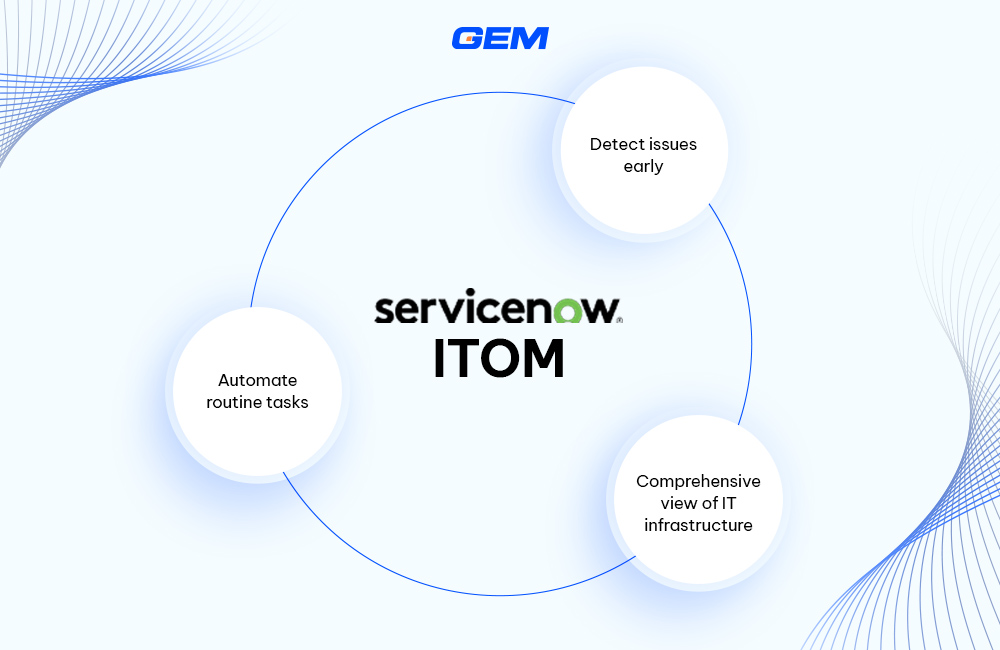
ServiceNow ITOM (IT Operations Management) is a cloud-based platform that helps organizations manage their IT infrastructure and services. It provides a unified view of IT resources, including computing, network, hardware, software, and cloud services, centralizing visibility across hybrid and multi-cloud environments. ITOM helps teams track real-time dependencies, monitor system health, and respond to operational issues before they affect users.
By mapping services to infrastructure and automating routine tasks, ITOM supports faster remediation, improved uptime, and informed decision-making. It also plays a key role in AIOps, event correlation, and policy-driven automation, making it a foundational layer for modern IT operations.
ServiceNow ITOM is most impactful in mid-size to large enterprises with complex IT estates, distributed environments, or high volumes of service incidents. It’s particularly relevant for organizations prioritizing system reliability, operational efficiency, and cloud cost optimization.
Breaking Down the Core ServiceNow ITOM Modules
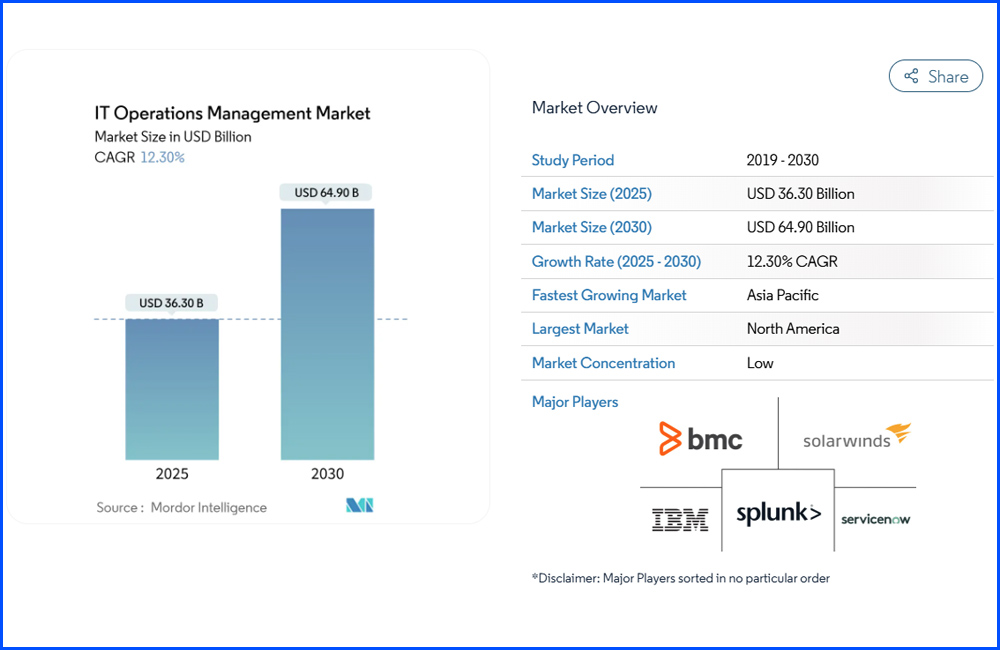
Source: Mordor Intelligence
The IT operations management market is valued at USD 36.3 billion in 2025 and is forecast to reach USD 64.9 billion by 2030, expanding at a 12.30% CAGR. Organizations are accelerating investments in ITOM as they undergo digital transformation to manage increasingly complex environments.
ServiceNow ITOM is built around modular capabilities that address different layers of operational complexity – spanning visibility, automation, observability, and risk mitigation. While organizations can adopt these modules in phases, their combined value lies in creating a unified, data-driven approach to managing IT infrastructure.
Read more: Managed Services: Unlock Seamless IT Support and Proactive Solutions for Your Business.
Agentic Workflows
Agentic workflows bring AI-driven automation directly into IT operations. These virtual agents collaborate across the incident lifecycle, starting from alert triage to contextual diagnostics, reducing the manual overhead on technical teams.
Key capabilities include:
- Automated alert triage and impact analysis
- Real-time context gathering using observability data
- Suggested assignees, resolution steps, and updated ticket descriptions
- Dynamic insights generated from historical incident and alert data
By connecting with observability partners and operational data sources, these agents break down silos and replace reactive workflows with proactive, insight-led action. This improves response time while maintaining consistency at scale.
ITOM Discovery
Discovery serves as the system’s foundation for infrastructure visibility. It scans across physical, virtual, and cloud environments to create an accurate and continuously updated inventory of IT assets.
Key functions:
- Unified discovery of on-premises, hybrid, cloud, and containerized resources
- Real-time visibility with cloud-native discovery methods
- Consolidation of tools through a single-agent framework
- Certified connectors that replace custom-built integrations
Discovery not only consolidates asset data into a single system of record, but it also powers upstream capabilities such as service mapping and configuration compliance by keeping the asset inventory current.
Service Mapping
Service Mapping visualizes the relationships between infrastructure components and the business services they support. This top-down approach helps teams understand service dependencies and prioritize issues based on business impact.
What it delivers:
- Automated creation of service maps using tag-based, traffic-based, and top-down methods
- Clear visibility into application services and their underlying components
- Impact-based problem detection and routing
- Support for service-aware operations across ITOM and ITSM
Service Mapping is particularly relevant for organizations running distributed or containerized applications, where visibility gaps can delay incident resolution or introduce operational risk.
Certificate Management
Certificate Management addresses operational risk tied to expiring TLS and PKI certificates – a growing concern as digital environments expand.
Capabilities include:
- Auto-discovery of deployed certificates across infrastructure
- Centralized inventory with expiration tracking
- Workflow automation for renewals and assignment
- Scalable processes to keep pace with rising certificate volumes
By removing manual tracking and automating renewal workflows, this module helps prevent outages and compliance violations linked to expired certificates while reducing administrative load on security and operations teams.
Firewall Audits and Reporting
Firewall policy management is often fragmented across tools and teams, making it difficult to track changes, validate compliance, or identify potential risks. This module consolidates firewall-related data into a single system of record, covering policies, ownership, software versions, and patch status.
Key capabilities:
- Unified view of all firewall assets and policies
- Automated workflows for rule change requests via ServiceNow Service Portal
- Built-in routing for security review and implementation approvals
- End-to-end visibility for audits, supported by tracking and reporting features
This module supports faster decision-making while strengthening governance and compliance by centralizing the firewall lifecycle.
Agent Client Collector (ACC)
ACC extends the ITOM platform by offering a unified agent-based approach to discovery, monitoring, and log collection. It complements agentless discovery models and expands visibility across environments where credential-based access or firewall exceptions aren’t feasible.
What it delivers:
- Expanded visibility into IT assets across cloud, on-prem, and edge environments
- AI-driven application fingerprinting to identify custom services
- Replacement of fragmented point monitoring solutions with a single agent
- Secure deployment with encryption and access controls
ACC plays a central role in standardizing how telemetry is collected across the IT estate, supporting both performance observability and compliance.
Event Management
With the volume of system events growing exponentially, event noise has become a major bottleneck for operations teams. This module applies AIOps and generative AI to transform raw event data into actionable intelligence.
Features include:
- Event correlation and deduplication to reduce alert fatigue
- Automated root cause identification using historical and contextual data
- GenAI-assisted alert descriptions that clarify technical jargon
- Integration with existing monitoring tools to centralize alerts
By reducing noise and surfacing probable causes, event management improves service availability and shortens incident resolution cycles.
Metric Intelligence
Metric Intelligence provides a continuous analysis layer across infrastructure performance, helping teams detect anomalies early and prevent repeat outages.
Core capabilities:
- Automated threshold setting to reduce manual tuning
- Anomaly detection across key performance indicators (KPIs)
- Post-incident analysis to confirm root cause and validate resolution
- CI-level insights to spot recurring issues
The module enables data-driven decisions around service health, equipping IT operations with the foresight needed to maintain consistent application performance.
Configuration Management Database (CMDB)
CMDB serves as the authoritative system of record for all configuration items (CIs) across the organization. It connects infrastructure elements, services, and dependencies, making it foundational to service mapping, change management, and incident diagnosis.
Key capabilities include:
- Integration with external systems through certified Service Graph Connectors
- Real-time updates to maintain data accuracy across digital lifecycles
- Continuous data quality assessments to support AI-driven decisions
- Automated context population for faster impact and risk analysis
An accurate CMDB reduces the risk of change-related incidents, improves root cause analysis, and supports audit-readiness across IT environments.
Health Log Analytics
Health Log Analytics applies machine learning to infrastructure and application logs, helping operations teams detect anomalies before they become service disruptions.
What it delivers:
- Early detection of failure patterns through AI-based log analysis
- Automated recommendations for issue remediation
- Centralized workspace that consolidates telemetry from multiple tools
- Visual dashboards for trend analysis and issue correlation
This module assists organizations in transitioning from reactive to preventive operations by integrating log data and delivering actionable insights, ultimately reducing the mean time to repair (MTTR).
Cloud Accelerate
Cloud Accelerate simplifies cloud account management while embedding governance and compliance into provisioning workflows. It improves visibility and control across multi-cloud environments without slowing down development or operations.
Key functions:
- Automated workflows for provisioning cloud resources
- Compliance tracking across accounts, regions, and services
- Streamlined collection of regulatory data for audits
- Self-service interface for requesting cloud environments
This module supports cost-effective cloud operations by aligning infrastructure provisioning with enterprise policy and compliance frameworks.
AIOps Learning Enhanced Automation Playbook (LEAP)
LEAP brings together generative AI and automation to accelerate incident resolution and reduce repetitive manual work. It learns from past incidents and operational data to build intelligent workflows that improve with use.
Capabilities include:
- Auto-generated remediation workflows based on historical incident patterns
- Real-time alerts enriched with context, probable cause, and resolution steps
- Integrated dashboards showing time saved, incidents addressed, and automation ROI
- Seamless integration with Field Service Management and Customer Service Management for proactive task creation
LEAP translates AIOps insights into practical outcomes, reducing operational costs while improving service reliability and user experience.
What You Gain with ServiceNow ITOM: Functional and Strategic Value
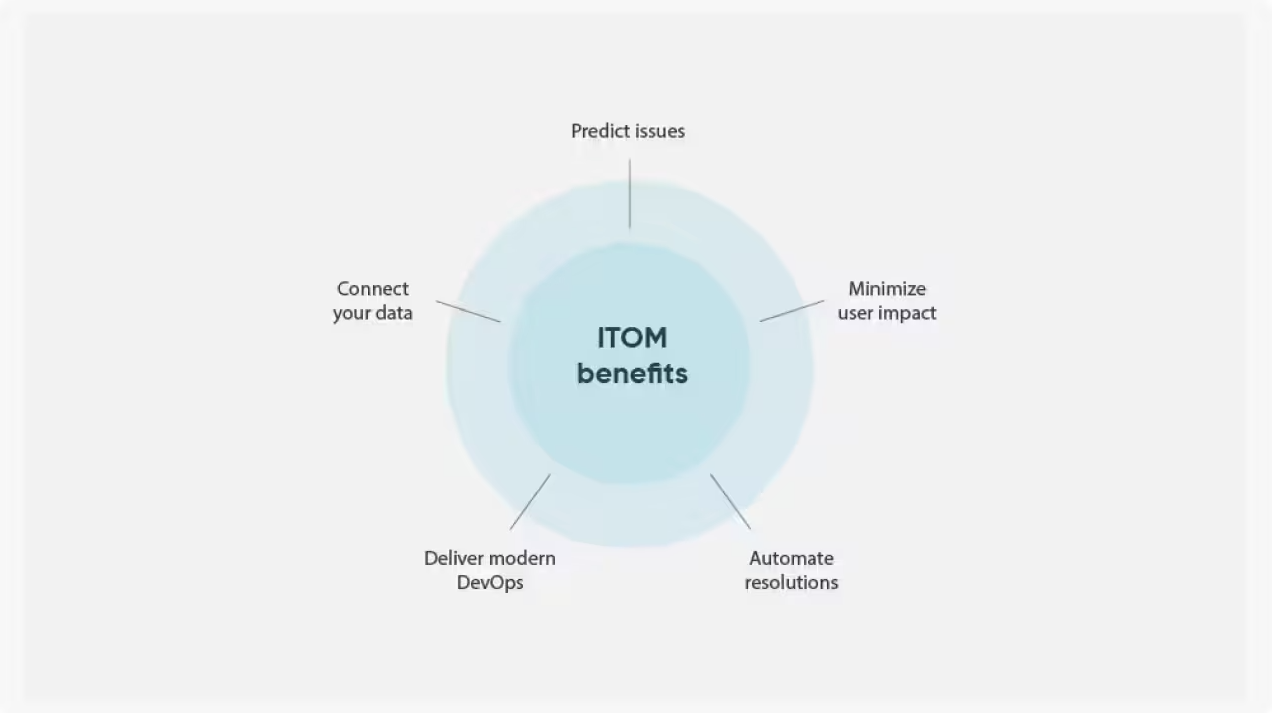
ServiceNow ITOM delivers measurable improvements across both day-to-day workflows and long-term operational resilience.
Reduced Service Outages
With real-time monitoring, anomaly detection, and automated response workflows, ITOM helps teams detect early warning signs of system degradation before they impact users. Modules like Event Management and Metric Intelligence pinpoint the root cause of disruptions and initiate remediation steps without delay, lowering downtime and preserving service continuity.
Faster Root Cause Analysis
Service Mapping, Health Log Analytics, and AIOps capabilities combine to create a connected view of incidents and infrastructure. This accelerates diagnostics by correlating alerts to configuration items (CIs), past incidents, and broader system behavior. Teams spend less time on triage and more time on resolution, improving MTTR.
Automated Remediation
Across the platform, automation is embedded within incident response, certificate management, firewall change workflows, and more. GenAI-driven playbooks in LEAP (Learning Enhanced Automation Playbook) dynamically generate scripts and workflows based on historical data, reducing manual effort and execution time. This not only accelerates resolution but also reduces error rates across operational processes.
Unified Visibility Across Hybrid Infrastructure
ServiceNow ITOM centralizes visibility across on-premises, cloud, and containerized environments. CMDB, Discovery, and the Agent Client Collector work together to maintain an up-to-date system of record, while Service Mapping overlays business context. This unified view supports better planning, risk analysis, and resource management across distributed environments.
Improved Compliance and Governance
Modules such as Cloud Accelerate and Firewall Audits help organizations standardize policy enforcement and track compliance across IT and cloud assets. By automating audit trails, approvals, and reporting, ITOM strengthens regulatory alignment without adding administrative burden. Certificate Management further reduces risk by automating renewals and lifecycle tracking.
Lower Operational Overhead Through Automation
From simplified alert handling to automated provisioning and AI-guided workflows, ServiceNow ITOM helps organizations reduce manual workloads across teams. This improves productivity, minimizes duplication, and allows IT resources to be allocated toward strategic initiatives rather than repetitive tasks.
Read more: ServiceNow CSM: Transform Your Customer Service Experience with Smarter Workflows.
ITOM vs. ITSM: Where They Overlap – And Where They Don’t
IT Service Management (ITSM) and IT Operations Management (ITOM) both fall under the broader umbrella of enterprise IT governance. While they share foundational concepts and often integrate within the same platform, they serve distinct functions and operate at different layers of the IT value chain.
ITSM
ITSM focuses on how IT services are planned, delivered, and managed over their lifecycle. It defines how users interact with IT through requests, incidents, and changes, and governs service-level commitments. The best-known framework guiding ITSM practices is ITIL, which outlines five phases, from service strategy to continual improvement.
Key responsibilities of ITSM include:
- Managing incidents, service requests, problems, and changes
- Operating a centralized service desk for user interaction
- Tracking service-level agreements (SLAs) and compliance
- Coordinating IT processes across business functions
ITOM
ITOM, on the other hand, deals with the operational stability and performance of the underlying IT infrastructure. It includes the tools and processes that monitor systems, automate remediation, and optimize performance across cloud, on-premises, and hybrid environments.
Core functions of ITOM typically involve:
- Real-time monitoring of infrastructure and applications
- Root cause analysis and automated remediation
- Configuration item (CI) discovery and service mapping
- Event correlation, metric intelligence, and AIOps
While there is overlap, particularly in the “Service Operation” phase of ITIL, each discipline brings its own focus:
- ITSM is service-centric and user-facing, driving consistency in how IT delivers support and value to internal users or customers.
- ITOM is infrastructure-centric and system-facing, enabling IT teams to maintain service availability and reduce downtime through operational insight.
In integrated environments, ITOM and ITSM often intersect:
- ITOM surfaces real-time telemetry and performance data that informs ITSM incident workflows.
- Automated playbooks from ITOM can be triggered by ITSM tickets.
- Configuration data from CMDB supports both change management (ITSM) and impact analysis (ITOM).
| Dimension | ITSM (IT Service Management) | ITOM (IT Operations Management) |
| Focus Area | Managing IT services across their lifecycle | Managing infrastructure operations and system health |
| Orientation | User-facing, service-centric | System-facing, infrastructure-centric |
| Core Activities | Incidents, service requests, changes, SLAs | Monitoring, discovery, event correlation, remediation |
| Framework Alignment | Full ITIL lifecycle | Primarily “Service Operation” in ITIL |
| Tools & Interfaces | Service desk, request portals, knowledge base | Dashboards, AIOps, CMDB, automation playbooks |
| Integration Points | Ticketing, approvals, SLAs | CMDB, alert analysis, automated root cause workflows |
| Outcome | Streamlined service delivery and user satisfaction | High availability and operational efficiency |
| Example Use Case | Processing a user’s request for hardware | Detecting a failing node and triggering auto-remediation |
Stop trying to find the dots. Let us help you connect them!
What’s the Real Cost? ServiceNow ITOM Pricing Packages
ServiceNow ITOM is structured around three tiered pricing packages, each designed to meet different levels of operational maturity. While the platform’s capabilities scale with each tier, pricing is not publicly disclosed in fixed amounts. Instead, it is determined based on an evaluation of your infrastructure, existing tools, and strategic goals.
ServiceNow ITOM Pricing Packages
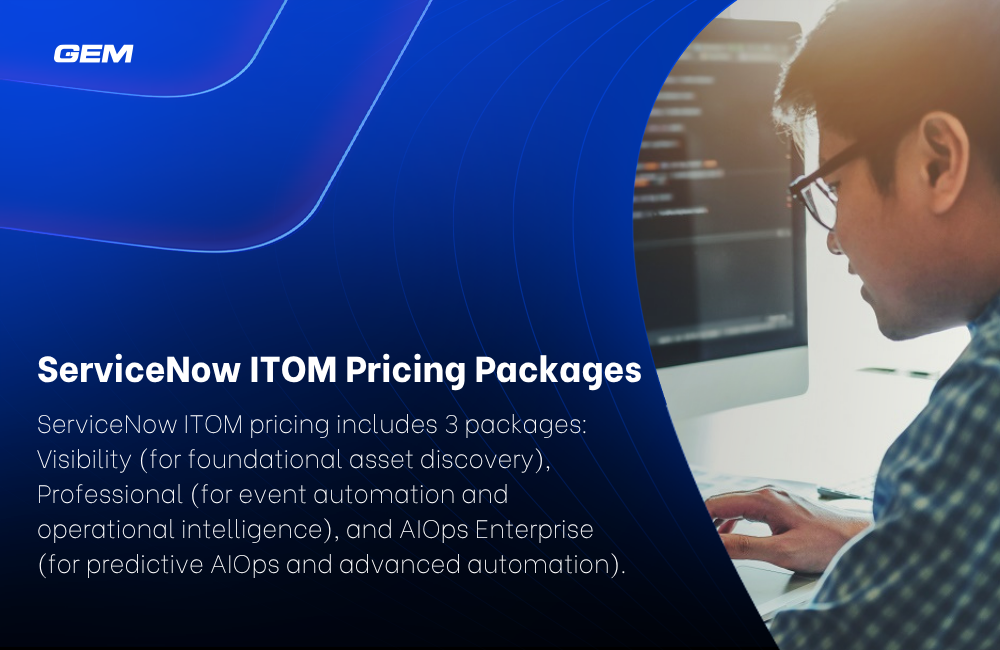
ITOM Visibility
This is the entry point into ServiceNow’s ITOM ecosystem, focused on infrastructure awareness and data accuracy. ITOM Visibility centralizes asset tracking and maps system dependencies, offering organizations foundational control over their configuration landscape.
Included capabilities:
- Discovery of IT assets across cloud, on-prem, and hybrid environments
- Service Mapping to visualize dependencies between infrastructure and business services
- Certificate Management for tracking and automating TLS certificate renewals
- Firewall Audits to consolidate and manage policy data
- Service Graph Connectors for third-party integration
- Configuration Management Database (CMDB) as the system of record
- Agent Client Collector for agent-based telemetry and monitoring
This package is typically suited for organizations prioritizing visibility, compliance, and data quality before layering on active automation or AIOps capabilities.
ITOM Professional
ITOM Professional builds on the Visibility package by adding operational intelligence and event-driven automation. It is designed for teams looking to move from static monitoring to coordinated incident response and service optimization.
In addition to all Visibility features, it includes:
- Event Management with AIOps to reduce alert noise and highlight probable root causes
- Metric Intelligence for anomaly detection and performance tracking
- Advanced Firewall Audits and Reporting to support risk analysis and governance
ITOM Professional is often selected by mid-sized to large enterprises that require centralized control of hybrid infrastructure, with the ability to act quickly on operational insights.
ITOM AIOps Enterprise
This is the most comprehensive package, tailored for enterprises with large-scale, distributed environments and a need for predictive intelligence. AIOps Enterprise adds machine learning models and automation frameworks that anticipate issues before they disrupt services.
Includes all Professional features, plus:
- Health Log Analytics to identify early indicators of outages through AI-based log analysis
- Cloud Accelerate for automated governance, compliance, and provisioning in multi-cloud environments
- GenAI-driven Learning Enhanced Automation Playbook (LEAP) for building and deploying automated remediation workflows
This package supports organizations aiming to modernize incident response, reduce manual overhead, and scale ITOM across complex environments.
What Influences the Cost of ServiceNow ITOM?
ServiceNow ITOM pricing is not off-the-shelf. It requires a tailored quote based on multiple variables:
Customization Requirements:
Integrations with legacy systems, custom workflows, and unique compliance needs can increase implementation scope and cost.
Implementation Complexity:
Deployment costs vary widely. A straightforward roll-out may begin around $10,000, whereas complex, multi-region implementations can exceed $100,000.
Scale of the Environment:
The number of assets, users, and infrastructure components directly impacts licensing and operational costs.
Support and Maintenance:
Ongoing costs include platform support, updates, and access to new features. These typically start around $200 per year and scale with usage.
Existing Tooling and Maturity:
Organizations migrating from legacy systems or consolidating multiple monitoring tools may see both short-term integration costs and long-term savings.
What to Expect in a Custom Quote
When engaging with ServiceNow or a consulting partner, the quoting process involves:
- A comprehensive review of your infrastructure footprint, including cloud accounts, servers, applications, and container stacks
- An assessment of current operational challenges and future growth objectives
- Identification of existing monitoring and ITSM tools to determine integration points
- Recommendations for a phased rollout aligned with your resource capacity and business priorities
Read more: ServiceNow ITOM vs ITSM: Optimize IT Operations and Service Delivery for Maximum Efficiency.
ITOM Implementation Timelines and Complexity: What to Expect
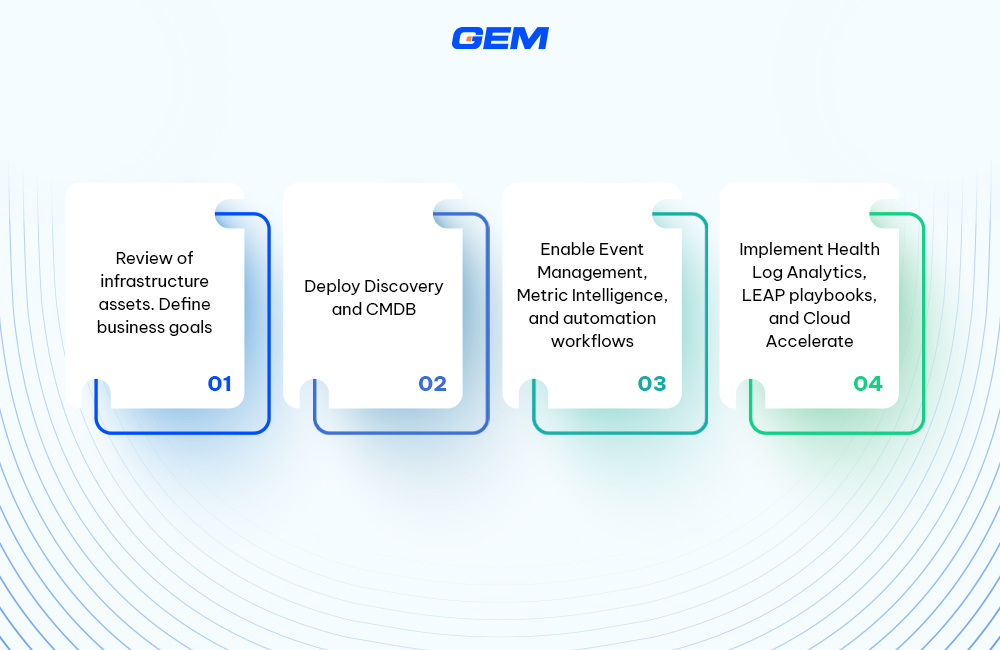
Deploying ServiceNow ITOM is not a plug-and-play exercise. The implementation often unfolds in defined phases, each requiring coordination across infrastructure, operations, and platform teams. Organizations should approach the rollout with a long-term roadmap rather than a single project view.
For mid-market companies, initial deployments typically range from 8 to 16 weeks. This covers foundational capabilities such as Discovery, CMDB population, and Service Mapping. For enterprise-scale rollouts involving multi-cloud environments, legacy system integrations, and AIOps adoption, timelines often extend to six months or more.
A standard phased approach includes:
Phase 1: Assessment and Planning (2–4 weeks)
Review of infrastructure assets, service dependencies, and existing monitoring tools. Definition of business goals and success metrics.
Phase 2: Foundational Setup (4–8 weeks)
Deployment of Discovery and CMDB. Configuration of Service Graph Connectors and Agent Client Collector. Establishing service maps.
Phase 3: Operational Use Cases (4–12 weeks)
Enablement of Event Management, Metric Intelligence, and automation workflows. Integration with ITSM for incident correlation.
Phase 4: AIOps and Advanced Automation (ongoing)
Implementation of Health Log Analytics, LEAP playbooks, and Cloud Accelerate. Continuous refinement based on operational feedback.
Common hurdles include poor-quality configuration data, lack of ownership for legacy systems, and resistance to workflow changes. These can delay time-to-value unless resolved early through stakeholder alignment and data readiness.
For organizations that streamline dependencies and prioritize high-impact use cases, early value is often visible within 60–90 days from go-live, particularly in areas such as alert reduction and faster incident triage.
Measuring the ROI of ServiceNow ITOM
Quantifying the return on investment from ServiceNow ITOM requires tracking both technical and operational outcomes. While direct cost savings are part of the picture, the broader value lies in time saved, incidents avoided, and improved service continuity.
Key ROI dimensions include:
- Mean Time to Resolution (MTTR)
Organizations using ITOM’s Event Management, Metric Intelligence, and AIOps capabilities report measurable MTTR reductions, often between 30% to 60%. By correlating alerts and providing probable root cause analysis, teams reduce time spent on triage and diagnosis.
- Infrastructure Cost Savings Through Cloud Optimization
Cloud Accelerate supports controlled provisioning and embedded governance. By avoiding over-provisioning and automating compliance checks, enterprises report infrastructure cost reductions in the 10% to 20% range, particularly across multi-cloud environments.
- Operational Efficiency Gains
Automation of certificate renewals, firewall audits, and incident remediation workflows cuts down manual effort and reduces error rates. In mature deployments, ITOM can support a 25% to 40% improvement in operational productivity, freeing up teams for strategic initiatives.
- Incident Volume Reduction via Event Correlation and Automation
Event Management filters out noise, consolidating thousands of raw alerts into a manageable set of actionable incidents. Combined with LEAP playbooks, many organizations experience a 40% to 70% drop in ticket volume at the service desk level.
Beyond these metrics, ITOM’s value compounds over time. As the system learns from infrastructure behavior and incident histories, automated workflows become more effective, and proactive remediation becomes the norm rather than the exception.
Read more: ServiceNow HRSD: Streamline Employee Services and Enhance Workforce Experience.
Implementing ServiceNow ITOM with GEM Corporation
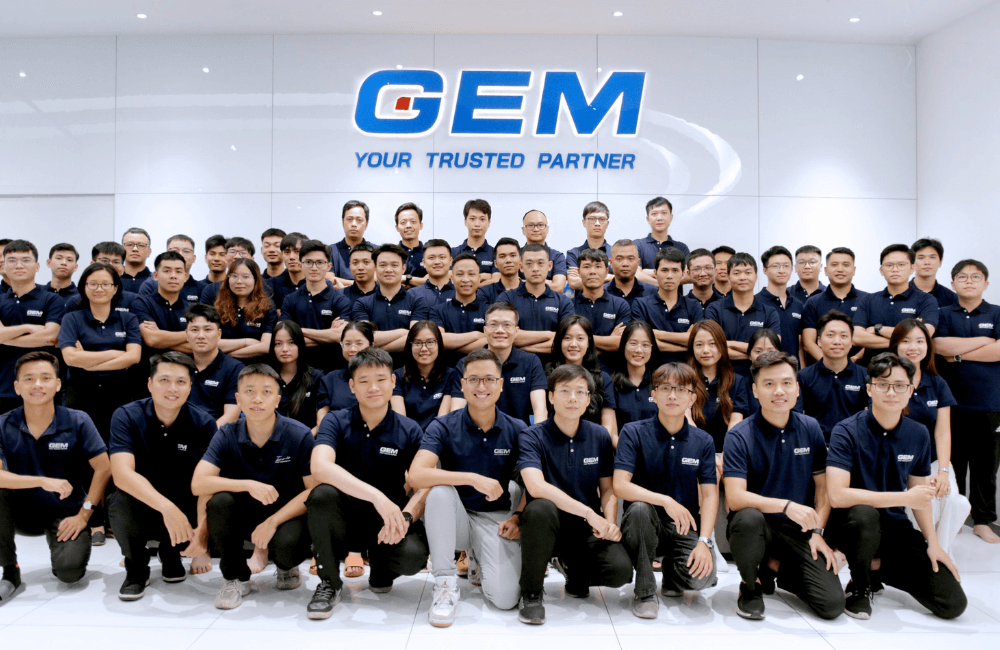
GEM Corporation is a global IT services and consulting firm, trusted by clients from Japan, ANZ, Asia, the EU, the US, and other key markets since 2014. With over 400 IT experts and a track record of delivering 300+ successful projects, GEM brings a comprehensive, domain-led approach to digital transformation. Our teams combine deep technical expertise with sector-specific insights to align technology initiatives with measurable business outcomes.
As a certified ServiceNow Partner, GEM offers end-to-end capabilities across the platform, from advisory and implementation to ongoing managed services. Our ServiceNow practice spans ITOM, ITSM, CSM, HRSD, and custom app development, with a focus on modular, value-driven deployments. We support clients through every phase of the transformation lifecycle, including architecture design, integration, and platform optimization. GEM’s delivery model is built for scale, helping enterprise and mid-market clients adopt ServiceNow ITOM in a phased, ROI-focused manner.
Conclusion
ServiceNow ITOM offers a modular path to operational insight, combining infrastructure visibility, event correlation, and AIOps into a single platform. Pricing reflects the scale, complexity, and maturity of your IT environment, while implementation timelines vary based on integration depth and organizational readiness. ROI emerges through faster resolution times, lower incident volumes, and improved resource efficiency. For enterprises seeking long-term value from their IT operations strategy, aligning capabilities with business goals is key.
Contact GEM to evaluate the right ServiceNow ITOM package for your environment and build a deployment roadmap tailored to your priorities.
What are the core modules included in ServiceNow ITOM, and what do they cover?
The ITOM suite includes several key modules: Discovery, Service Mapping, Event Management, Cloud Management, and Operational Intelligence. Together, they support asset visibility, dependency mapping, anomaly detection, and cloud orchestration, creating a unified operational backbone for IT teams.
How does ServiceNow ITOM differ from ITSM, and where do they intersect?
While ITSM focuses on managing service requests, incidents, and changes, ITOM is built to monitor systems, automate infrastructure tasks, and predict issues before they escalate. The two intersect around configuration management (CMDB) and incident resolution, but ITOM extends deeper into infrastructure operations and preventative action.
What factors influence ServiceNow ITOM pricing, and what should buyers expect?
Pricing is typically based on a tiered model aligned with module selection and deployment scale. Costs vary depending on the number of devices, nodes, or cloud resources monitored. Organizations should also factor in licensing for supporting modules, integration needs, and ongoing platform maintenance when estimating total cost of ownership.
How can organizations measure ROI from a ServiceNow ITOM deployment?
Return on investment is often realized through reduced downtime, faster incident resolution, and lower manual effort for routine tasks. Many businesses also cite improved audit readiness and better cloud spend management as strategic gains. Measuring ROI requires tracking metrics across system availability, response times, and operational costs over time.
